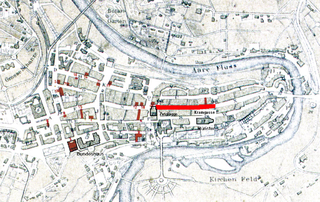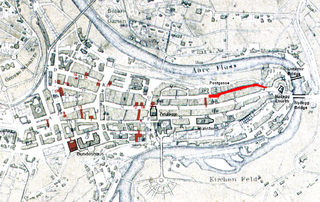
The Old City is the medieval city center of Bern, Switzerland. Built on a narrow hill bordered on three sides by the river Aare, its compact layout has remained essentially unchanged since its construction during the twelfth to the fifteenth century. Despite a major fire in 1405, after which much of the city was rebuilt in sandstone, and substantial construction efforts in the eighteenth century, Bern's old city has retained its medieval character.

The Kramgasse is one of the principal streets in the Old City of Bern, the medieval city centre of Bern, Switzerland. It was the center of urban life in Bern until the 19th century. Today, it is a popular shopping street. Its length, slight curve and long line of Baroque façades combine to produce Bern's most impressive streetscape.

The Gerechtigkeitsgasse is one of the principal streets in the Old City of Bern, the medieval city center of Bern, Switzerland. Together with its extension, the Kramgasse, it is the heart of the inner city. Hans Gieng's most famous fountain figure, the statue of Lady Justice on the Gerechtigkeitsbrunnen, commands the view of the street's gentle slopes and curves.

The Herrengasse is one of the streets in the Old City of Bern, the medieval city center of Bern, Switzerland. It was the southernmost street of the old Zähringerstadt of Bern and ended at the first city wall. Three buildings on the Herrengasse are listed on the Swiss inventory of heritage site of national significance and it is part of the UNESCO Cultural World Heritage Site that encompasses the Old City.

The Aarbergergasse is one of the streets in the Old City of Bern, the medieval city center of Bern, Switzerland. It was originally the most important of the five streets that were part of the Äussere Neustadt, which was the section outside the city walls. One fountain, the Ryfflibrunnen on the Aarbergergasse is listed on the Swiss inventory of heritage site of national significance and it is part of the UNESCO Cultural World Heritage Site that encompasses the Old City.

The Münstergasse is one of the streets in the Old City of Bern, the medieval city center of Bern, Switzerland. It is part of the Zähringerstadt which was built during the foundation of the old city in 1191. However, until 1967 it was parts of several other streets. It runs along the cathedral and it is part of the UNESCO Cultural World Heritage Site that encompasses the Old City.

The Münsterplatz is a plaza in the Old City of Bern, the medieval city center of Bern, Switzerland. It is part of the Zähringerstadt which was built during the foundation of the old city in 1191. It is located in front of the Cathedral and it is part of the UNESCO Cultural World Heritage Site that encompasses the Old City.

The Marktgasse is one of the streets in the Old City of Bern, the medieval city center of Bern, Switzerland. It is part of the Innere Neustadt which was built during the 13th Century. It runs from the Käfigturm between Waisenhausplatz and Bärenplatz in the west to the Zytglogge between Kornhausplatz and Theaterplatz in the east. It is part of the UNESCO Cultural World Heritage Site that encompasses the Old City.

The Neuengasse is one of the streets in the Old City of Bern, the medieval city center of Bern, Switzerland. It is part of the Äussere Neustadt which was built during the third expansion of the city in 1344 to 1346. It runs from Waisenhausplatz in the east toward the main train station. It is part of the UNESCO Cultural World Heritage Site that encompasses the Old City.

The Rathausgasse is one of the streets in the Old City of Bern, the medieval city center of Bern, Switzerland. It is part of the Zähringerstadt which was built during the foundation of the city in 1191. It runs from the transverse Kreuzgasse, where the name changes to Postgasse to Kornhausplatz. It is part of the UNESCO Cultural World Heritage Site that encompasses the Old City.

The Postgasse is one of the streets in the Old City of Bern, the medieval city center of Bern, Switzerland. It is part of the Zähringerstadt which was built during the foundation of the city in 1191. It runs from Nydeggstalden near the Aare river in the east to the transverse Kreuzgasse, where the name changes to Rathausgasse. It is part of the UNESCO Cultural World Heritage Site that encompasses the Old City.

The Spitalgasse is one of the streets in the Old City of Bern, the medieval city center of Bern, Switzerland. It is part of the Äussere Neustadt which was built during the third expansion from 1344 to 1346. The eastern end is at Waisenhausplatz and Bärenplatz while the western end is at Bahnhofplatz near the Church of the Holy Ghost. It is part of the UNESCO Cultural World Heritage Site that encompasses the Old City.

The Zeughausgasse is one of the streets in the Old City of Bern, the medieval city center of Bern, Switzerland. It is part of the Innere Neustadt which was built during the second expansion in 1255 to 1260. The eastern end is at Kornhausplatz while the western end is at Waisenhausplatz. It is part of the UNESCO Cultural World Heritage Site that encompasses the Old City.

The Zähringerstadt is a historic section in the Old City of Bern in Bern, Switzerland.

The Bärenplatz is a plaza in the Old City of Bern, the medieval city center of Bern, Switzerland. It is part of the Innere Neustadt which was built during the second expansion from 1255 to 1260. It is located north of Bundesplatz, west of Käfigturm and south of Waisenhausplatz. It is part of the UNESCO Cultural World Heritage Site that encompasses the Old City.

The Bahnhofplatz is a plaza just outside the Old City of Bern, the medieval city center of Bern, Switzerland. It was built following the destruction of the Christoffelturm which had been part of the third city wall. It is located north of Bubenbergplatz and surrounds the Heiliggeistkirche and Bern's central train station. It is part of the UNESCO Cultural World Heritage Site that encompasses the Old City.

The Bubenbergplatz is a plaza in the Old City of Bern, the medieval city center of Bern, Switzerland. It is part of the area outside the third city walls. It is located south-west of Bahnhofplatz and is part of the UNESCO Cultural World Heritage Site that encompasses the Old City.

The Bundesplatz is the Government Plaza in Bern, the de facto capital city of Switzerland. It is situated in the Old City of Bern, the medieval city center of Bern. It is part of the Innere Neustadt which was built during the second expansion in 1255 to 1260, though the plaza was not built until much later. It is located in front of the Bundeshaus, the Swiss Parliament Building, and it is part of the UNESCO Cultural World Heritage Site that encompasses the Old City.

The Kornhausplatz is a plaza in the Old City of Bern, the medieval city center of Bern, Switzerland. It is on the edge of the Zähringerstadt which was built during the founding of the city in 1191, though the plaza wasn't built until later. It is located near the Kornhausbrücke and the Zytglogge clock tower. It is part of the UNESCO Cultural World Heritage Site that encompasses the Old City.

The Holländerturm is a former defensive tower in the old city of Bern in Switzerland. It is part of the UNESCO Cultural World Heritage Site of the Old City of Bern. The tower was originally part of the city wall of Bern but was absorbed by the house at Waisenhausplatz 15.





















